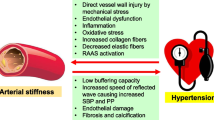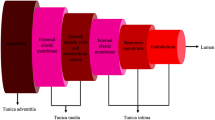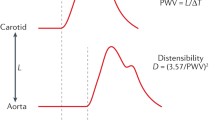Abstract
Purpose of Review
To update and review novel insights into the mechanisms, measurements, and therapeutic approaches to arterial stiffness.
Recent Findings
Arterial (e.g., vascular) stiffness has been shown over time to prognosticate for cardiovascular and kidney outcomes. In this context, there has been increased interest behind the mechanisms that drive arterial stiffness beyond aging and interest in how to apply newer technologies in measurement of arterial stiffness. Pulse wave velocity has been the gold standard for measurement but industry has been innovating to improve measurement with use of single-point PWV as well as pharmacologic approaches with anti-hypertensives and oral hypoglycemic agents. Emerging data on the role of the mineralocorticoid receptor, the endothelial sodium channel (EnNaC), and uric acid in arterial stiffness are promising a number of potential therapies.
Summary
Newer techniques of measuring PWV for arterial stiffness and novel therapies may soon lead to better outcomes from hypertension complications.

Similar content being viewed by others
References
Papers of particular interest, published recently, have been highlighted as: • Of importance •• Of major Importance
•• Safar ME. Arterial stiffness as a risk factor for clinical hypertension. Nat Rev Cardiol. 2018;15(2):97–105. This paper provides a concise update on the importance of arterial stiffness as a risk factor in hypertensive patients.
Smulyan H, Lieber A, Safar ME. Hypertension, diabetes type II, and their association: role of arterial stiffness. Am J Hypertens. 2016;29(1):5–13.
Niiranen TJ, Kalesan B, Hamburg NM, Benjamin EJ, Mitchell GF, Vasan RS. Relative contributions of arterial stiffness and hypertension to cardiovascular disease: the Framingham Heart tudy. J Am Heart Assoc. 2016;5(11):e004271.
Townsend RR, Wilkinson IB, Schiffrin EL, Avolio AP, Chirinos JA, Cockcroft JR, et al. Recommendations for improving and standardizing vascular research on arterial stiffness: a scientific Statement from the American Heart Association. Hypertension. 2015;66(3):698–722.
Reference Values for Arterial Stiffness C. Determinants of pulse wave velocity in healthy people and in the presence of cardiovascular risk factors: ‘establishing normal and reference values’. Eur Heart J. 2010;31(19):2338–50.
Laurent P, Marenco P, Castagna O, Smulyan H, Blacher J, Safar ME. Differences in central systolic blood pressure and aortic stiffness between aerobically trained and sedentary individuals. J Am Soc Hypertens. 2011;5(2):85–93.
Tanaka H, Safar ME. Influence of lifestyle modification on arterial stiffness and wave reflections. Am J Hypertens. 2005;18(1):137–44.
Briet M, Schiffrin EL. Treatment of arterial remodeling in essential hypertension. Curr Hypertens Rep. 2013;15(1):3–9.
Padilla J, Ramirez-Perez FI, Habibi J, Bostick B, Aroor AR, Hayden MR, et al. Regular exercise reduces endothelial cortical stiffness in western diet-fed female mice. Hypertension. 2016;68(5):1236–44.
•• Avolio AP, Butlin M, Walsh A. Arterial blood pressure measurement and pulse wave analysis—their role in enhancing cardiovascular assessment. Physiol Meas. 2010;31(1):R1–47. This is a very insightful review of the history of arterial waveform measurements in blood pressure and arterial stiffness.
Booth J. A short history of blood pressure measurement. Proc R Soc Med. 1977;70(11):793–9.
Lewis O. Stephen Hales and the measurement of blood pressure. J Hum Hypertens. 1994;8(12):865–71.
Wilkinson IB, MacCallum H, Hupperetz PC, van Thoor CJ, Cockcroft JR, Webb DJ. Changes in the derived central pressure waveform and pulse pressure in response to angiotensin II and noradrenaline in man. J Physiol. 2001;530(Pt 3):541–50.
O’Rourke MF, Pauca A, Jiang XJ. Pulse wave analysis. Br J Clin Pharmacol. 2001;51(6):507–22.
Esper SA, Pinsky MR. Arterial waveform analysis. Best Pract Res Clin Anaesthesiol. 2014;28(4):363–80.
Boutouyrie P, Fliser D, Goldsmith D, Covic A, Wiecek A, Ortiz A, et al. Assessment of arterial stiffness for clinical and epidemiological studies: methodological considerations for validation and entry into the European Renal and Cardiovascular Medicine registry. Nephrol Dial Transplant. 2014;29(2):232–9.
Obeid H, Khettab H, Marais L, Hallab M, Laurent S, Boutouyrie P. Evaluation of arterial stiffness by finger-toe pulse wave velocity: optimization of signal processing and clinical validation. J Hypertens. 2017;35(8):1618–25.
Van Bortel LM, Laurent S, Boutouyrie P, Chowienczyk P, Cruickshank JK, De Backer T, et al. Expert consensus document on the measurement of aortic stiffness in daily practice using carotid-femoral pulse wave velocity. J Hypertens. 2012;30(3):445–8.
Weber T, Wassertheurer S, Rammer M, Haiden A, Hametner B, Eber B. Wave reflections, assessed with a novel method for pulse wave separation, are associated with end-organ damage and clinical outcomes. Hypertension. 2012;60(2):534–41.
Hajjar I, Goldstein FC, Martin GS, Quyyumi AA. Roles of arterial stiffness and blood pressure in hypertension-associated cognitive decline in healthy adults. Hypertension. 2016;67(1):171–5.
Ferruzzi J, Madziva D, Caulk AW, Tellides G, Humphrey JD. Compromised mechanical homeostasis in arterial aging and associated cardiovascular consequences. Biomech Model Mechanobiol. 2018. https://doi.org/10.1007/s10237-018-1026-7.
•• Teren A, Beutner F, Wirkner K, Loffler M, Scholz M. Relationship between determinants of arterial stiffness assessed by diastolic and suprasystolic pulse oscillometry: comparison of Vicorder and Vascular Explorer. Medicine (Baltimore). 2016;95(10):e2963. This paper reviews the use of PWV for the measurement of arterial stiffness while providing a comparison of different oscillometric modalities that can be used to assess it
Lyle AN, Raaz U. Killing me unsoftly: causes and mechanisms of arterial stiffness. Arterioscler Thromb Vasc Biol. 2017;37(2):e1–e11.
•• DeMarco VG, Aroor AR, Sowers JR. The pathophysiology of hypertension in patients with obesity. Nat Rev Endocrinol. 2014;10(6):364–76. A paper that explores the complex links between obesity, hypertension and vascular dysfunction.
•• Cabandugama PK, Gardner MJ, Sowers JR. The renin angiotensin aldosterone system in obesity and hypertension: Roles in the Cardiorenal Metabolic Syndrome. Med Clin N Am. 2017;101(1):129–37. This provides an update on the most recent literature on the pathophysiology of insulin resistance, obesity, and renin angiotensin aldosterone system-mediated oxidative stress on endothelial dysfunction and the pathogenesis of hypertension.
•• Aroor AR, Demarco VG, Jia G, Sun Z, Nistala R, Meininger GA, et al. The role of tissue renin-angiotensin-aldosterone system in the development of endothelial dysfunction and arterial stiffness. Front Endocrinol. 2013;4:161. This is a careful analysis of the interaction between angiotensin and aldosterone shows the importance of mineralocorticoid receptors in modulation of insulin resistance, decreased bioavailability of nitric oxide, endothelial dysfunction, and arterial stiffness.
Barhoumi T, Kasal DA, Li MW, Shbat L, Laurant P, Neves MF, et al. T regulatory lymphocytes prevent angiotensin II-induced hypertension and vascular injury. Hypertension. 2011;57(3):469–76.
Benetos A, Safar ME. Aortic collagen, aortic stiffness, and AT1 receptors in experimental and human hypertension. Can J Physiol Pharmacol. 1996;74(7):862–6.
Zieman SJ, Melenovsky V, Kass DA. Mechanisms, pathophysiology, and therapy of arterial stiffness. Arterioscler Thromb Vasc Biol. 2005;25(5):932–43.
Nguyen Dinh Cat A, Montezano AC, Burger D, Touyz RM. Angiotensin II, NADPH oxidase, and redox signaling in the vasculature. Antioxid Redox Signal. 2013;19(10):1110–20.
Hamlyn JM, Linde CI, Gao J, Huang BS, Golovina VA, Blaustein MP, et al. Neuroendocrine humoral and vascular components in the pressor pathway for brain angiotensin II: a new axis in long term blood pressure control. PLoS One. 2014;9(9):e108916.
Tirosh A, Garg R, Adler GK. Mineralocorticoid receptor antagonists and the metabolic syndrome. Curr Hypertens Rep. 2010;12(4):252–7.
McCurley A, McGraw A, Pruthi D, Jaffe IZ. Smooth muscle cell mineralocorticoid receptors: role in vascular function and contribution to cardiovascular disease. Pflugers Arch. 2013;465(12):1661–70.
•• DeMarco VG, Habibi J, Jia G, Aroor AR, Ramirez-Perez FI, Martinez-Lemus LA, et al. Low-dose mineralocorticoid receptor blockade prevents Western diet-induced arterial stiffening in female mice. Hypertension. 2015;66(1):99–107. https://doi.org/10.1161/HYPERTENSIONAHA.115.05674. Epub 2015 May 26. This paper explores the activation of vascular mineralocorticoid receptors in Western Diet fed mice and how the use of subpressor doses of spironolactone preserved normal arterial stiffness.
•• Jia G, Habibi J, Aroor AR, Martinez-Lemus LA, DeMarco VG, Ramirez-Perez FI, et al. Endothelial mineralocorticoid receptor mediates diet-induced aortic stiffness in females. Circ Res. 2016;118(6):935–43. This paper shows how increased endothelial cell mineralocorticoid receptors (ECMR) signaling associated with consumption of a Western Diet plays a key role in endothelial sodium channel activation and resultant arterial stiffness in female mice.
Martinez-Lemus LA, Aroor AR, Ramirez-Perez FI, Jia G, Habibi J, DeMarco VG, et al. Amiloride improved endothelial function and reduces vascular stiffness in female mice fed a Western diet. Front Physiol. 2017;8:456. https://doi.org/10.3389/fphys.2017.00456. eCollection 2017
Jia G, Aroor AR, DeMarco VG, Martinez-Lemus LA, Meininger GA, Sowers JR. Vascular stiffness in insulin resistance and obesity. Front Physiol. 2015;6:231.
Brillante DG, O’Sullivan AJ, Howes LG. Arterial stiffness in insulin resistance: the role of nitric oxide and angiotensin II receptors. Vasc Health Risk Manag. 2009;5(1):73–8.
• Canepa M, Viazzi F, Strait JB, Ameri P, Pontremoli R, Brunelli C, et al. Longitudinal association between serum uric acid and arterial stiffness: results from the Baltimore Longitudinal Study of Aging. Hypertension. 2017;69(2):228–35. This study demonstrates the clinical relevance of raised serum uric acid levels as a risk factor in arterial stiffness and hypertension.
Mehta T, Nuccio E, McFann K, Madero M, Sarnak MJ, Jalal D. Association of uric acid with vascular stiffness in the Framingham Heart Study. Am J Hypertens. 2015;28(7):877–83.
Aroor AR, Jia G, Habibi J, Sun Z, Ramirez-Perez FI, Brady B, et al. Uric acid promotes vascular stiffness, maladaptive inflammatory responses and proteinuria in western diet fed mice. Metabolism. 2017;74:32–40.
de Faria AP, Modolo R, Fontana V, Moreno H. Adipokines: novel players in resistant hypertension. J Clin Hypertens (Greenwich). 2014;16(10):754–9. https://doi.org/10.1111/jch.12399.
•• Sabbatini AR, Fontana V, Laurent S, Moreno H. An update on the role of adipokines in arterial stiffness and hypertension. J Hypertens. 2015;33(3):435–44. A paper reviewing the proposed mechanisms by which various adipokines contribute to arterial stiffness.
Achari AE, Jain SK. Adiponectin: a therapeutic target for obesity, diabetes, and endothelial dysfunction. Int J Mol Sci. 2017;18(6). https://doi.org/10.3390/ijms18061321
Yiannikouris F, Gupte M, Putnam K, Cassis L. Adipokines and blood pressure control. Curr Opin Nephrol Hypertens. 2010;19(2):195–200.
Su H, Lau WB, Ma XL. Hypoadiponectinaemia in diabetes mellitus type 2: molecular mechanisms and clinical significance. Clin Exp Pharmacol Physiol. 2011;38(12):897–904.
Ebrahimi-Mamaeghani M, Mohammadi S, Arefhosseini SR, Fallah P, Bazi Z. Adiponectin as a potential biomarker of vascular disease. Vasc Health Risk Manag. 2015;11:55–70.
El Khoudary SR, Barinas-Mitchell E, White J, Sutton-Tyrrell K, Kuller LH, Curb JD, et al. Adiponectin, systolic blood pressure, and alcohol consumption are associated with more aortic stiffness progression among apparently healthy men. Atherosclerosis. 2012;225(2):475–80.
Kim CS, Bae EH, Ma SK, Park SK, Lee JY, Chung W, et al. Association of serum adiponectin concentration with aortic arterial stiffness in chronic kidney disease: from the KNOW-CKD study. Clin Exp Nephrol. 2017;21(4):608–16.
Soderberg S, Colquhoun D, Keech A, Yallop J, Barnes EH, Pollicino C, et al. Leptin, but not adiponectin, is a predictor of recurrent cardiovascular events in men: results from the LIPID study. Int J Obes. 2009;33(1):123–30.
Xue B, Yu Y, Zhang Z, Guo F, Beltz TG, Thunhorst RL, et al. Leptin mediates high-fat diet sensitization of angiotensin II-elicited hypertension by upregulating the brain renin-angiotensin system and inflammation. Hypertension. 2016;67(5):970–6.
Noblet JN, Goodwill AG, Sassoon DJ, Kiel AM, Tune JD. Leptin augments coronary vasoconstriction and smooth muscle proliferation via a Rho-kinase-dependent pathway. Basic Res Cardiol. 2016;111(3):25.
Jamaluddin MS, Weakley SM, Yao Q, Chen C. Resistin: functional roles and therapeutic considerations for cardiovascular disease. Br J Pharmacol. 2012;165(3):622–32.
Jung HS, Park KH, Cho YM, Chung SS, Cho HJ, Cho SY, et al. Resistin is secreted from macrophages in atheromas and promotes atherosclerosis. Cardiovasc Res. 2006;69(1):76–85.
Steppan CM, Bailey ST, Bhat S, Brown EJ, Banerjee RR, Wright CM, et al. The hormone resistin links obesity to diabetes. Nature. 2001;409(6818):307–12.
Barbaro NR, Fontana V, Modolo R, De Faria AP, Sabbatini AR, Fonseca FH, et al. Increased arterial stiffness in resistant hypertension is associated with inflammatory biomarkers. Blood Press. 2015;24(1):7–13. https://doi.org/10.3109/08037051.2014.940710.
Mozos I, Malainer C, Horbanczuk J, Gug C, Stoian D, Luca CT, et al. Inflammatory markers for arterial stiffness in cardiovascular diseases. Front Immunol. 2017;8:1058.
• Tomiyama H, Shiina K, Matsumoto-Nakano C, Ninomiya T, Komatsu S, Kimura K, et al. The contribution of inflammation to the development of hypertension mediated by increased arterial stiffness. J Am Heart Assoc. 2017;6(7):e005729. https://doi.org/10.1161/JAHA.117.005729. This paper presents results of a study conducted in Japan suggesting that long-term inflammation may be associated with increased vascular stiffness.
• Pikilidou M, Yavropoulou M, Antoniou M, Yovos J. The contribution of osteoprogenitor cells to arterial stiffness and hypertension. J Vasc Res. 2015;52(1):32–40. https://doi.org/10.1159/000381098. This paper looks at how circulating stem cells—Osteoprogenitor cells—can deposit bone matrix proteins in the vascular wall and contribute to arterial stiffness.
Aoki A, Kojima F, Uchida K, Tanaka Y, Nitta K. Associations between vascular calcification, arterial stiffness and bone mineral density in chronic hemodialysis patients. Geriatr Gerontol Int. 2009;9(3):246–52.
David M, Malti O, AlGhatrif M, Wright J, Canepa M, Strait JB. Pulse wave velocity testing in the Baltimore longitudinal study of aging. J Vis Exp. 2014;7(84):e50817. https://doi.org/10.3791/50817.
Baulmann J, Schillings U, Rickert S, Uen S, Düsing R, Illyes M, et al. A new oscillometric method for assessment of arterial stiffness: comparison with tonometric and piezo-electronic methods. J Hypertens. 2008;26(3):523–8. https://doi.org/10.1097/HJH.0b013e3282f314f7.
Zhang Y, Agnoletti D, Xu Y, Wang JG, Blacher J, Safar ME. Carotid-femoral pulse wave velocity in the elderly. J Hypertens. 2014;32:1572–6.
Butlin M, Qasem A, Battista F, Bozec E, McEniery CM, Millet-Amaury E, et al. Carotid-femoral pulse wave velocity assessment using novel cuff-based techniques: comparison with tonometric measurement. J Hypertens. 2013;31:2237–43.
P M N, Joseph J, Sivaprakasam M. A magnetic plethysmograph probe for local pulse wave velocity measurement. IEEE Trans Biomed Circuits Syst. 2017;11(5):1065–76.
•• Campo D, Khettab H, Yu R, Genain N, Edouard P, Buard N, et al. Novel Arterial Stiffness measurement methods- Measurement of aortic pulse wave velocity with a connected bathroom scale. Am J Hypertens. 2017. https://doi.org/10.1093/ajh/hpx059. This paper shows one of the innovative steps being taken to make PWV measurement more assessible using a bathroom scale.
Maroules CD, Khera A, Ayers C, Goel A, Peshock RM, Abbara S, et al. Cardiovascular outcome associations among cardiovascular magnetic resonance measures of arterial stiffness: the Dallas heart study. J Cardiovasc Magn Reson. 2014;16:33.
Skrzypczyk P, Pańczyk-Tomaszewska M. Methods to evaluate arterial structure and function in children—state-of-the art knowledge. Adv Med Sci. 2017;62(2):280–294. https://doi.org/10.1016/j.advms.2017.03.001. Epub 2017 May 11.
Yang T, Jiang X, Zhong Y, Zhao X, Lin S, Li J, et al. A wearable and highly sensitive Graphene strain sensor for precise home-based pulse wave monitoring. ACS Sens. 2017;2(7):967–974. https://doi.org/10.1021/acssensors.7b00230. Epub 2017 Jul 13.
•• Saiki A, Sato Y, Watanabe R, Watanabe Y, Imamura H, Yamaguchi T, et al. The role of a novel arterial stiffness parameter, cardio-ankle vascular index (CAVI), as a surrogate marker for cardiovascular diseases. J Atheroscler Thromb. 2016;23(2):155–68. https://doi.org/10.5551/jat.32797. This paper looks at the use of a new parameter, the cardio-ankle vascular index (CAVI), for the measurement of arterial stiffness, in order to overcome some of the drawbacks of the PWV.
O’Donovan C, Lithander FE, Raftery T, Gormley J, Mahmud A, Hussey J. Inverse relationship between physical activity and arterial stiffness in adults with hypertension. J Phys Act Health. 2014;11(2):272–7. https://doi.org/10.1123/jpah.2012-0075.
Tahara N, Yamagishi SI, Bekki M, Kodama N, Nakamura T, Sugiyama Y, et al. Anagliptin, a dipeptidyl peptidase-4 inhibitor ameliorates arterial stiffness in association with reduction of remnant-like particle cholesterol and alanine transaminase levels in type 2 diabetic patients. Curr Vasc Pharmacol. 2016;14(6):552–62.
de Boer SA, Heerspink HJL, Juarez Orozco LE, van Roon AM, Kamphuisen PW, Smit AJ, et al. Effect of linagliptin on pulse wave velocity in early type 2 diabetes: a randomized, double-blind, controlled 26-week trial (RELEASE). Diabetes Obes Metab. 2017;19(8):1147–54.
Duvnjak L, Blaslov K. Dipeptidyl peptidase-4 inhibitors improve arterial stiffness, blood pressure, lipid profile and inflammation parameters in patients with type 2 diabetes mellitus. Diabetol Metab Syndr. 2016;8:26.
•• Tahara N, Yamagish SI, Bekki M, Tahara A, Igata S, Honda A, et al. Switching dipeptidyl peptidase-4 inhibitors to tofogliflozin, a selective inhibitor of sodium-glucose cotransporter 2 improves arterial stiffness evaluated by cardio-ankle vascular index in patients with type 2 diabetes. Curr Vasc Pharmacol. 2018. https://doi.org/10.2174/1570161116666180515154555. This study showed that a switch from a dipeptidyl peptidase-4 inhibitors DPP-4 to an sodium-glucose cotransporter 2 SGLT2 significantly reduced arterial stiffness in type 2 diabetes mellitus.
Lee DM, Battson ML, Jarrell DK, Hou S, Ecton KE, Weir TL, et al. SGLT2 inhibition via dapagliflozin improves generalized vascular dysfunction and alters the gut microbiota in type 2 diabetic mice. Cardiovasc Diabetol. 2018;17(1):62.
Funding
This work has received financial support by a VA Merit to Adam Whaley-Connell and a Dialysis Clinics Inc, research grant to Ravi Nistala.
Author information
Authors and Affiliations
Corresponding author
Ethics declarations
Conflict of Interest
Dr. Shoemaker-Moyle reports grants from Dialysis Clinics Inc. and from Veterans Administration, during the conduct of the study. Dr. Nistala reports grants from Dialysis Clinics Inc. during the conduct of the study. The other authors declare no conflicts of interest relevant to this manuscript.
Human and Animal Rights and Informed Consent
This article does not contain any studies with human or animal subjects performed by any of the authors.
Additional information
This article is part of the Topical Collection on Hypertension and the Kidney
Rights and permissions
About this article
Cite this article
Dumor, K., Shoemaker-Moyle, M., Nistala, R. et al. Arterial Stiffness in Hypertension: an Update. Curr Hypertens Rep 20, 72 (2018). https://doi.org/10.1007/s11906-018-0867-x
Published:
DOI: https://doi.org/10.1007/s11906-018-0867-x




